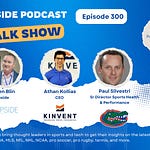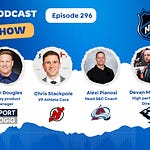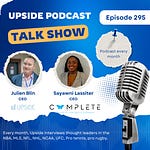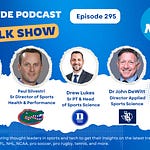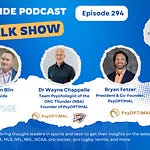Today we have the honor to interview Gordon Waddington, Australian Institute of Sport/University of Canberra Professor of Sports Medicine Research and Co-founder, Prism Neuro; and also Elizabeth McGrath who is CEO & Co founder of Prism Neuro.
Prism Neuro will be exhibiting and speaking at our NY Sports tech Summit at Citi Field on November 15, so if you want to book a meeting with the Prism Neuro team click on the link below:
Prism Neuro is an early stage start-up focused on solutions to measure and improve human movement control. Their technology has applications in sport for identifying talent and monitoring the performance of movement control pathways; in space for studying and preventing the loss of motor control that comes from exposure to microgravity; and in health where ageing, injury and disease can all have negative impacts on the movement control system.
📝Show Notes: Through this interview, we touched on their backgrounds, and their company and product. We also discussed the benefits for sports organizations and athletes to use their product. Lastly we talked about their competitive advantage, business model and plans for the next 12 months.
Best Quotes: Here’s some of the key discussion points and best quotes from our conversation with Elizabeth and Gordon:
On their backgrounds:
Elizabeth McGrath:
“I'm a biomedical engineer by training. And I did my PhD research at the Naval Aerospace Medical Research Lab in Pensacola, Florida. While I was there, I was working on fighter pilot selection and one of the things that's really important for pilots, and especially fighter pilots, because of the G's they pull and the maneuvers they do, is spatial awareness”.
“Spatial awareness comes primarily from your visual and vestibular systems that give you information about what's going on around you. They also give you information about what your own body is doing in that context. So it's really important for pilots to have excellent spatial awareness”.
“We also knew we needed to consider information coming from the body, not just the eyes and inner ear, and that’s where Gordon’s work comes in.”
Gordon Waddington:
“I started out as a physiotherapist, being in the clinical space for a long time, particularly focusing on lower limb injury and recovery and function of the lower limbs. And actually now we are in 2023, would you believe that it marks 30 years of clinical and research work in this space for me”.
“My focus has been very much as Elizabeth suggested on that periphery and how information transfers back to the brain from the periphery. I think historically, we've focused on strength and recovery, cardiovascular recovery, flexibility, those sorts of things, which are all sort of about the engine, the motor system, not so much about the sensory and the receptor system.”
“Some really interesting things have come out over more recent years in the sensory space”.
On the issues that they identified with the nerve trunks when athletes are coming back from injuries:
Gordon Waddington:
“We now know, for instance, that approximately 93% of the nerve trunks coming back through to the brain, are bringing back information from the periphery, only about 7% is the actual motor control”.
“So the way I look at that is it's a bit like having a high performance car, when we're talking about an athlete. With a dirty windscreen you can do all the work on that engine and push it as fast as you can, but if the picture through the windscreen is blurry, that is to say, unless the sensory control systems are working really well, that's still a big factor in terms of performance”.
On how their product at Prism Neuro works and it can measure the athlete’s vestibular system, the visual system, and the somatosensory system:
Gordon Waddington:
“Now we've got the capacity to look at the three systems that keep us upright and keep us mobile. The vestibular system, the visual system, and the somatosensory system. And like many of these things it comes down to in science, if you can't see it, it doesn't get investigated. So building the tools to actually measure things like the somatosensory, the proprioceptive system in the periphery, that's been certainly the focus of my research and that's been built over the years to what we have now, which is a validated system for measuring that space.“
On what stage of the product they are now and the pilots they are conducting with elite teams, Olympic teams, and astronauts:
Elizabeth McGrath:
“Right now we're in a pilot program with beta prototype systems out in the field with pilot customers. So we're very close to launching commercially. We’re having a lot of great success, great feedback from the pilot trials that we've got going on, and the customers that we’re with, including elite teams, Olympic teams. We're also doing some space research with MIT because it's really important for astronauts as well. We're also involved in a clinical trial because movement control matters for everyone, this is not just for elite athletes”.
On their plan to launch their product in 2H24 in North America:
Elizabeth McGrath:
“We plan to launch our product commercially in the second half of 2024. Now we still have availability for a few more pilot customers in our trial, so we'd love to get a few different types of sports on board. Our product will be primarily available in the U. S. And then it will be available in Europe after that”.
On the fact that their product requires 2 to 5 minutes tests:
Elizabeth McGrath:
“The way it works is that it's two five-minute tests and what we're measuring is the function of those neurosensory pathways - your visual and vestibular systems, and your proprioceptive system. And those, as Gordon said, can be like a dirty windscreen. If you're getting fuzzy information, or not accurate information back from those systems, then the motor signals your brain produces are going to be less accurate”.
Gordon Waddington:
“It is quite a step change, and it is different from the conventional biomechanics physiology process. It is the technical area of psychophysics. So how the brain perceives, its response to changes in the physical world around it”.
“We're using psychophysics measures for lower limb perception for the somatosensory side of it. And the visual vestibular assessment utilizes very standard types of psychophysics that have been established for a long time in Elizabeth's space. So it's the combination of those that's different and the reality is that basically nobody is doing what we're doing at the moment”.
On their product’s ability to look at the athlete’s current state of performance and his/her history of how well that injury has been rehabbed:
Gordon Waddington:
“What the measure does is that it actually starts to give you an idea of what that person's history is, whether they've had injury. We obviously can't specifically identify that, but your history of injury contributes to your current state of performance and your history of how well that injury has been rehabbed through this particularly. Where you are now is the accumulation of all of that back story to your system”.
“One of the problems with human brains, and of course the wonderful advantage of human brains, is plasticity - because the brain can continually change. If for a period of time after an injury, you change the input systems, then the synapses change centrally, the model changes, and that then can become set in the system. And so that's what we can start to get a global picture of with this sort of assessment. (…) It allows teams to have another window into the complexity of what that athlete’s recovery looks like”.
Elizabeth McGrath:
“It's more than just healing properly. Because these athletes are in elite pathways most of them are able to access world class rehab to ensure that their muscles are back, their bones are set, the physical performance measures are up to scratch - speed and jump and cut and all of that. But it's this neural connection, the brain-body connection, where the brain is sending neural signals and reading neural signals from the body that might not have recovered fully. That's what we're tapping into”.
On the fact that the Prism Neuro product can be used to assess the recovery of athletes who suffered various types (ACL, concussions..) of injuries:
Gordon Waddington:
“Our product can be used across athletes who had an ACL injury or a concussion. If you think of this as being an estimate of measure of change in the central nervous system rather than just something that's happening out in the periphery or just something that's happening at the eye, it's the fundamental control system for the whole of movement that we're tapping into”.
“And that's critical then in that sense, it doesn't really matter what the injuries are. If you had a hip injury, if you had an ACL injury, you'll see side to side differences, left, right differences, substantial differences, even though the brain attached is the same brain operating left and right leg, you see those sort of performance differences, which could potentially contribute to a future injury”.
“So, yes, it applies to all injuries and to concussion as well. Concussion is a very interesting one because obviously it's on top of everybody's minds in the collision and contact sports these days. What you're doing is disturbing that central structure of the brain for a period of time. You're taking out certain pathways of feedback for a certain period of time and you've got to look at reactivating that process.
“When I started out in physio, it was all about mechanical things. You pushed on things. You got people to stretch things. You got people to load weights. This is a whole new idea that is really a focus on the neural system and the neural control system. And of course, the technologies that we have now allow us to do that in ways that we couldn't have possibly even thought of five or 10 years ago”.
“Like Elizabeth said, there is that evidence from the neurosciences and imaging of structures like the cerebellar cortex and the motor cortex, where you can see substantial shifts in the size of those after injuries, particularly like ACLs. The longer you are in rehab, often the worse that decrease in brain cross sectional areas is. And the person wouldn't know that - there's no cognitive difference”.
On the fact that their product can help reverse the effects of injuries:
Gordon Waddington:
“And that's the big space that we're in, that subsequent injury picture, trying to effectively identify that athlete who's got those decrements, we then try to minimize and reverse that”.
“Roughly 80% of your injury burden costs in a team environment will come from only 20% of your players, and they're the ones that get re injured”.
Elizabeth McGrath:
“The evidence shows that athletes who have a prior injury are more likely to be injured and people are starting to recognize this [movement control deficits] is probably one of the underlying causes of that reinjury. Even concussion can lead to further musculoskeletal injury”.
“And what's really coming out now is that it is the motor control pathways that are affected, that the concussion is affecting visual vestibular especially, but also other regions of the brain. And that's not being fully monitored for recovery. So that's where we can help. There is not much out there to do that”.
On the fact that they built the first of its kind product on the market today:
Elizabeth McGrath:
“We're doing something that no one else is doing, and we're providing information that's not available from any other source. And it's proving in our pilot engagements to add value. And it is something that's been supported through research for a very long time. And just as Gordon said, it's a step change and maybe not yet embraced fully, but we're the 1st company to put this all together”.
On the use of their testing and rehab products during injury recovery
Gordon Waddington:
“So for following through on a rehab process, the actual assessment side of it is effective once a week, just to give you an indication of direction of change.”
“The actual rehab side with the rehab tools is two to three times a week. On top of the standard protocol, 2 to 3 times a week, looking at about a total of 10, somewhere between 10 and 20 minutes depending on the process with the athlete. It’s actually quite powerful when you're getting the coordinated rehab aspect of it”.
On their business model and pricing model:
Elizabeth McGrath:
“Basically, it's a hardware enabled SaaS business model, because our main product, the testing system, is really about the data that it generates. So the business model is that the equipment is an upfront purchase, and then it's used through license to our cloud for the testing and the analytics”.
On their plans for the next 12 months:
Elizabeth McGrath:
“In addition to the commercial launch of our testing system, we're working on developing products in the rehab space as Gordon mentioned. We do already have some rehab tools in trials, so we have a few more that we're going to be developing as well so we can launch those next year. That's our focus and we will be looking to do a raise most likely starting in about 6 months time”.
You may also like:
⚡ 📈 Upside: Injury Risk Assessment Solutions Ecosystem (Key Trends, Vendors, Recommendations to Teams) Analysis
Over the last decade, injury risk assessment has become a major challenge for many pro teams and leagues. For example, as shown in the graph below, among US sports leagues, the cost of injuries has skyrocketed over the years and totaled $700M and $500M for the MLB and NFL, respectively, in 2017. This is why pro teams and leagues are now investing heavil…
🔥 Upside Chat: Dave Hancock, CEO, Apollo (Leading Athlete Management Systems (AMS) vendor)
🔥 Upside Chat: Dr Andy Barr, Consultant, Brooklyn Nets (NBA) & Quantum Performance Founder








